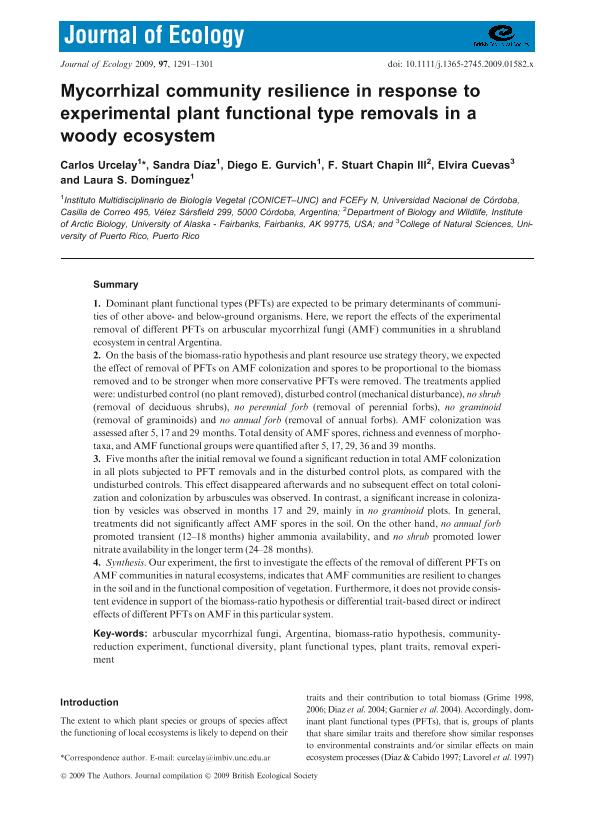Artículo
Mycorrhizal community resilience in response to experimental plant functional type removals in a woody ecosystem
Urcelay, Roberto Carlos ; Díaz, Sandra Myrna
; Díaz, Sandra Myrna ; Gurvich, Diego Ezequiel
; Gurvich, Diego Ezequiel ; Chapin, F. Stuart; Cuevas, Elvira; Dominguez, Laura Susana
; Chapin, F. Stuart; Cuevas, Elvira; Dominguez, Laura Susana
 ; Díaz, Sandra Myrna
; Díaz, Sandra Myrna ; Gurvich, Diego Ezequiel
; Gurvich, Diego Ezequiel ; Chapin, F. Stuart; Cuevas, Elvira; Dominguez, Laura Susana
; Chapin, F. Stuart; Cuevas, Elvira; Dominguez, Laura Susana
Fecha de publicación:
09/2009
Editorial:
Wiley
Revista:
Journal of Ecology
ISSN:
0022-0477
e-ISSN:
1365-2745
Idioma:
Inglés
Tipo de recurso:
Artículo publicado
Clasificación temática:
Resumen
1. Dominant plant functional types (PFTs) are expected to be primary determinants of communities of other above- and below-ground organisms. Here, we report the effects of the experimental removal of different PFTs on arbuscular mycorrhizal fungi (AMF) communities in a shrubland ecosystem in central Argentina. 2. On the basis of the biomass-ratio hypothesis and plant resource use strategy theory, we expected the effect of removal of PFTs on AMF colonization and spores to be proportional to the biomass removed and to be stronger when more conservative PFTs were removed. The treatments applied were: undisturbed control (no plant removed), disturbed control (mechanical disturbance), no shrub (removal of deciduous shrubs), no perennial forb (removal of perennial forbs), no graminoid (removal of graminoids) and no annual forb (removal of annual forbs). AMF colonization was assessed after 5, 17 and 29 months. Total density of AMF spores, richness and evenness of morphotaxa, and AMF functional groups were quantified after 5, 17, 29, 36 and 39 months. 3. Five months after the initial removal we found a significant reduction in total AMF colonization in all plots subjected to PFT removals and in the disturbed control plots, as compared with the undisturbed controls. This effect disappeared afterwards and no subsequent effect on total colonization and colonization by arbuscules was observed. In contrast, a significant increase in colonization by vesicles was observed in months 17 and 29, mainly in no graminoid plots. In general, treatments did not significantly affect AMF spores in the soil. On the other hand, no annual forb promoted transient (12–18 months) higher ammonia availability, and no shrub promoted lower nitrate availability in the longer term (24–28 months). 4. Synthesis. Our experiment, the first to investigate the effects of the removal of different PFTs on AMF communities in natural ecosystems, indicates that AMF communities are resilient to changes in the soil and in the functional composition of vegetation. Furthermore, it does not provide consistent evidence in support of the biomass-ratio hypothesis or differential trait-based direct or indirect effects of different PFTs on AMF in this particular system.
Archivos asociados
Licencia
Identificadores
Colecciones
Articulos(IMBIV)
Articulos de INST.MULTIDISCIPL.DE BIOLOGIA VEGETAL (P)
Articulos de INST.MULTIDISCIPL.DE BIOLOGIA VEGETAL (P)
Citación
Urcelay, Roberto Carlos; Díaz, Sandra Myrna; Gurvich, Diego Ezequiel; Chapin, F. Stuart; Cuevas, Elvira; et al.; Mycorrhizal community resilience in response to experimental plant functional type removals in a woody ecosystem; Wiley; Journal of Ecology; 97; 6; 9-2009; 1291-1301
Compartir
Altmétricas



